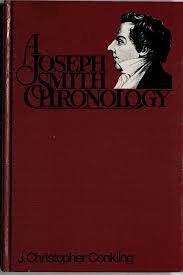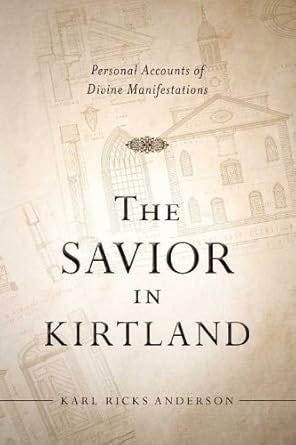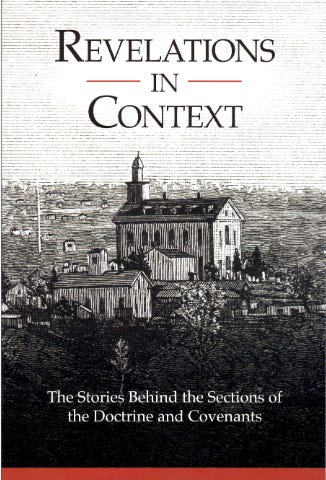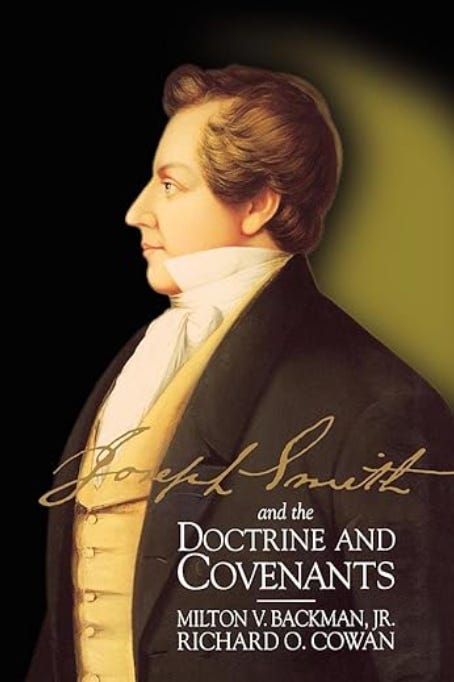With a Little Caution, and Some Wisdom
The Historical Background for Doctrine and Covenants 46-48
On March 8, 1831, the Prophet Joseph Smith received the revelations that are now Doctrine and Covenants 46 and 47, and soon thereafter, in mid-March of 1831, the Saints inquired of Joseph about where the New York Saints would settle and he received what is now Doctrine and Covenants 48. (See Conkling’s A Joseph Smith Chronology, p. 22)
The description of the historical background for D&C 46-48 in the LDS Come Follow Me manual is helpful:
As Parley P. Pratt, Oliver Cowdery, Ziba Peterson, and Peter Whitmer Jr. left Kirtland and moved on to continue preaching the gospel, they left more than 100 new members of the Church who had plenty of zeal but little experience or direction. They had no instructional handbooks, no leadership training meetings, no broadcasts of general conference—in fact, they didn’t even have enough copies of the Book of Mormon to go around. Many of these new believers had been drawn to the restored gospel by the promise of marvelous manifestations of the Spirit, especially those described in the New Testament (see, for example, 1 Corinthians 12:1–11). But many found it hard to identify true manifestations of the Spirit. Seeing the confusion, Joseph Smith prayed for help. The Lord’s answer is valuable today, when people often deny or ignore the things of the Spirit. He reaffirmed that spiritual manifestations are real. He also clarified what they are: gifts from a loving Heavenly Father, “given for the benefit of those who love [Him] and keep all [His] commandments, and him that seeketh so to do” (Doctrine and Covenants 46:9).
In Lyndon W. Cook’s The Revelations of the Prophet Joseph Smith we learn more about the historical background for these sections (46-48):
Section 46
Date. 8 March 1831.
Place. Kirtland, Geauga County, Ohio.
Historical Note. On 8 March 1831 Joseph Smith and Sidney Rigdon began translating the New Testament. John Whitmer, who also assisted in the work of revision at this time, recorded that discussion relative to admitting non-members to sacrament and confirmation meetings served as the basis for receiving section 46. Barring the unbaptized from Church meetings, said Whitmer, had “caused some to marvel, and converse about this matter.” Verses 3-6 clarified that “earnest seekers” should be permitted to attend.
The revelation also instructed the Saints to seek the best spiritual gifts, and warned of being deceived by false spirits.
Publication Note. Section 46 was first published in the Evening and Morning Star (August 1832) and was included as chapter 49 in the Book of Commandments in 1833.
Section 47
Date. 8 March 1831.
Place. Kirtland, Geauga County, Ohio.
Historical Note. According to John Whitmer, Joseph Smith informed him that it was his responsibility to “keep the church history.” Whitmer replied that he would prefer not to have that assignment but would do it if it was the will of the Lord. In response to Whitmer’s desire for a revelation on the matter, the Prophet inquired of the Lord and received section 47. Although the directive for Whitmer to be the custodian of the Church history was given on 8 March 1831, he was not ordained to this position until 9 April 1831.
The history that John Whitmer wrote as Church Historian began on 12 June 1831 and continued until he left the Church. He called this history, “The Book of John Whitmer.” Prior to this appointment, John Whitmer had served as scribe to Joseph Smith in the work of translating the Bible and in copying revelations received by Joseph Smith. Inasmuch as section 47 instructed Whitmer to transcribe “all things” given to the Prophet, it is significant to note that this revelation was given one day after Joseph Smith had received a directive to begin translation of the New Testament.
On 31 July 1832 Joseph Smith reminded John Whitmer of “the commandment to him to keep a history of the church & the gathering and beware [to keep] himself approved whereunto he hath ben called.” A year later, expressing convern over his calling as Church historian, Whitmer wrote to Oliver Cowdery, “I want you to remember me to Joseph in a special manner, and enquire of him respecting my clerkship [;] you very well know what I mean & also my great desire of doing all things according to the mind of the Lord.”
After his excommunication in 1838, John Whitmer refused to turn over his history to the Church. The record eventually became the property of the Reorganized LDS Church.
The “other office” to which Oliver Cowdery had been appointed (verse 5) was undoubtedly that of “second elder,” and missionary to the Lamanites (D&C 20:3; 28:8).
Publication Note. Section 47 was first published as chapter 50 in the Book of Commandments in 1833.
Section 48
Date. March 1831.
Place. Kirtland, Geauga County, Ohio.
Historical Note. Section 42 (1833 edition) had directed the membership of the Church in Ohio to “assist the Bishop in obtaining places for the brethren from New York.” Because the New York Saints, in Fayette, Manchester, and Colesville, were making preparations to move to Ohio, Church leaders were naturally concerned as to “how they should act in regard to purchasing lands” on which the New York Saints could settle. Upon inquiry Joseph Smith received section 48. The revelation directed the Ohio Saints to share their surplus properties with the New Yorkers, and if more was needed, it would have to be purchased by the newcomers.
Publication Note. Section 48 was first published as chapter 51 in the Book of Commandments in 1833.
Much of the historical context for these sections includes difficulties in the Church associated with correctly discerning spiritual manifestations. These difficulties were exacerbated as the missionaries, Oliver Cowdery, Parley P. Pratt, Peter Whitmer Jr., and Ziba Peterson, left for Missouri, and as other prominent leaders, such as Sidney Rigdon and Edward Partridge, left Kirtland to meet Joseph Smith in New York, leaving a small group of converts with fervent excitement about spiritual gifts and without experienced leadership.
Obviously the Prophet Joseph Smith’s absence was felt, but the absence of other more experienced members of the Church was also significant. For example, at the beginning of his book The Savior in Kirtland, Karl Ricks Anderson emphasizes the powerful influence that Sidney Rigdon had in particular upon the early Saints.
The absence of the most experience leaders together with the religious fervor of the Second Great Awakening combined to create a perfect storm of strange spiritual manifestations in the Church. In his excellent chapter “Religious Enthusiasm among Early Ohio Converts,” in Revelations in Context, Matthew McBride sheds more light on the nature of these strange spiritual manifestations and how the Lord corrected these problems. In sum, the Lord revealed true doctrine to His servant Joseph Smith who summarized these events thus:
“Some strange notions and false spirits had crept in among them. With a little caution, and some wisdom, I soon assisted the brethren and sisters to overcome them. … The false spirits were easily discerned and rejected by the light of revelation.”14
In their book Joseph Smith and the Doctrine and Covenants, Milton V. Backman, Jr. and Richard O. Cowan, share more details about how the early Saints learned to correctly discern spiritual manifestations:
Doctrine and Covenants 46 and 50 deal specifically with gifts of the Spirit and how to detect false spiritual manifestations. Levi Hancock described the strange exercises of some converts in 1831: “Those elders ran into all manner of doings, receiving revelations and seeing angels. Falling down frothing at the mouth. … I have seen [one of them] jump up from the floor, strike his head against the joist in the Baldwins new house and swing some minutes, then fall like he was dead. After an hour or two he would come to. He would prophesy and tell what he had seen” (“Autobiography,” pp. 27).
Many years later, Elder George A. Smith recalled these problems in Kirtland. He declared that after the missionaries to the Lamanites left for Missouri and “Sidney Rigdon took a journey to the east, as did Edward Partridge for the purpose of visiting the Prophet” that “these strange spirits… began to manifest themselves in the churches and Branches which had been built up.
“There was at this time in Kirtland, a society that had undertaken to have a community of property; it has sometimes been denominated the Morley Family, as there was a number of them located on a farm owned by Captain Isaac Morley. These persons had been baptized, but had not yet been instructed in relation to their duties. A false spirit entered into them, developing their singular, extravagant and wild ideas. They had a meeting at the farm, and among them was a negro known generally as Black Pete, who became a revelator. Others also manifested wonderful developments; they could see angels, and letters would come down from heaven, they said, and they would be put through wonderful unnatural distortions. Finally on one occasion, Black Pete got sight of one of those revelations…, he started after it, and ran off a steep wash bank twenty-five feet high, passed through a tree top into the Chagrin river beneath. He came out with a few scratches, and his ardor somewhat cooled.
“Joseph Smith came to Kirtland, and taught that people in relation to their error. He showed them that the Spirit of God did not bind men nor make them insane, and that the power of the adversary which had been manifested in many instances was visible even from that cause, for persons under its influence became helpless, and were bound hand and foot as in chains, being as immovable as a stick of timber. When Joseph came to instruct these Saints in relation to the true Spirit, and the manner of determining the one from the other, in a short time a number of those who had been influenced by those foul manifestations, apostatized” (Journal of Discourses, 11:3-4).
Parley P. Pratt also described behavior of the Saints that led him and others to seek counsel from the Prophet:
“As I went forth among the different branches, some very strange spiritual operations were manifested, which were disgusting, rather than edifying. Some persons would seem to swoon away, and make unseemly gestures, and be drawn or disfigured in their countenances. Others would fall into ecstasies, and be drawn into contortions, cramp, fits, etc. Others would seem to have visions and revelations, which were not edifying, and which were not congenial to the doctrine and spirit of the gospel. In short, a false and lying spirit seemed to be creeping into the Church.
“All these things were new and strange to me, and had originated in the Church during our absence, and previous to the arrival of President Joseph Smith from New York.
“Feeling our weakness and inexperience, and lest we should err in judgment concerning these spiritual phenomena, myself, John Murdock, and several other Elders, went to Joseph Smith, and asked him to inquire of the Lord concerning these spirits or manifestations.
“After we had joined in prayer in his translating room, he dictated in our presence the following revelation: [D&C 50]” (Autobiography, pp. 61-62). This revelation emphasized that the Lord’s servants could discern the source of such manifestations by the Spirit and that spiritual gifts from God edify and help one to grow in light until reaching the ‘perfect day’ (D&C 50:24).” (pp. 57-58)
With this historical background and context in mind, we are better equipped to understand what it means to earnestly seek the best gifts, and why such spiritual gifts are vital in the Lord’s Restored Church.







